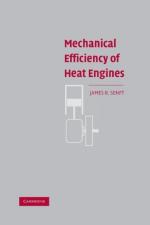|
This section contains 613 words (approx. 3 pages at 300 words per page) |

|
A heat engine is defined as any engine that uses heat to perform work. As such, the physics underlying the operation of a heat engine is a direct consequence of the first law of thermodynamics. Heat engines take heat from a higher temperature heat source and transform it into work and a release of heat in the lower temperature surroundings, Heat engines can also convert internal energy (heat) into mechanical energy.
A classical description of a heat engine is provided by the Carnot cycle, named after its inventor Nicolas-L(onard-Sadi Carnot, who first designed it in 1824. The Carnot heat engine is only used as a standard of heat engine performance. It operates as a reversible process and consists of a gas confined by a piston moving back and forth in a cylinder. The process has four steps. First, the gas is heated and it expands, moving...
|
This section contains 613 words (approx. 3 pages at 300 words per page) |

|


